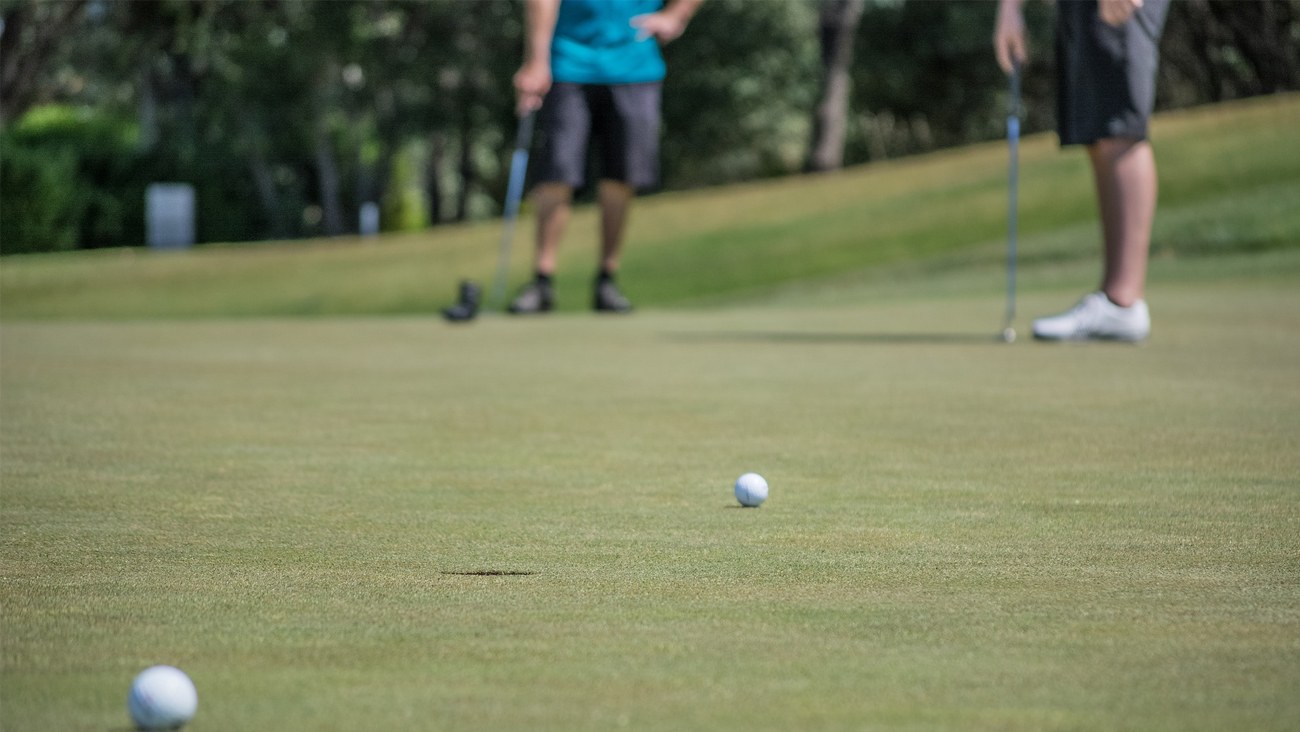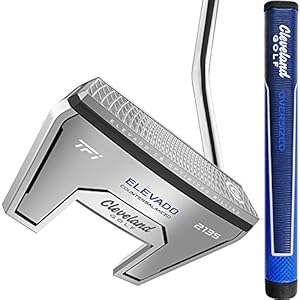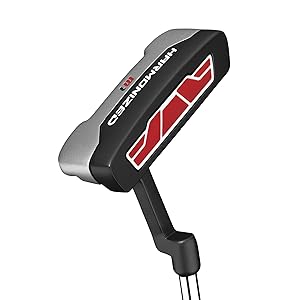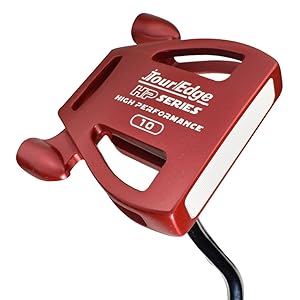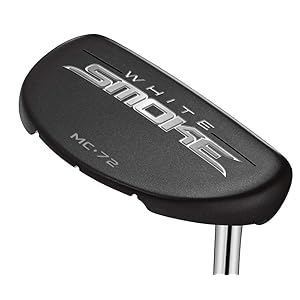When people start playing golf, often one of the first things on their mind is the driving range. It’s easy to obsess over chasing that elusive “perfect” swing while putting all of your efforts into your long game. However, your short game and in particular putting is what gets the ball in the hole. With roughly 40% of shots taken with a putter, practicing is key to shaving strokes off your game. That said, you need to make sure you have the right tool for the job. In this article, we take a look at some of the best beginner putters around.
The Best Beginner Putters
If you’re new to the game, you’re probably feeling overwhelmed by the amount of new information to take in. The last thing you want to do is worry about buying poor quality clubs. We’ve rounded up some of our favorite putters that are excellent for beginners.
Here’s a list of our 5 best beginner putters which are easily good enough to keep you going.
Odyssey Hot Pro 2.0 Putter
The Odyssey Hot Pro 2.0 is first up on the list. It’s a very well engineered club, aiming to provide you with consistent feedback upon impact with the ball. The design behind these clubs is tour inspired, with a gunmetal PVD finish that helps to prevent glare.
The key word for this putter is one we’ve already mentioned: consistency. It feels like an incredibly balanced putter. This is down to the Odyssey putting technology, including the white-hot insert which gives it a soft feel across the face of the club. You’ve got freedom in terms of style, with a selection of putter variations all with different sizes of clubhead. Not to mention, a choice between a standard or jumbo grip. If you’re looking for a beginner putter that punches above its price tag, we’d recommend you seriously consider the Odyssey Hot Pro 2.0.
Cleveland Golf 2135 Satin Elevado Putter
The Cleveland TFI 2135 range was introduced in 2016, but are still among the best beginner putters in the business. Technology-wise, this putter is a real game changer. We love the distinctive sightline, which is 21.35 mm off the ground to make for perfect alignment with the center of the ball.
Cleveland makes use of different milling patterns to help optimize the Moment of Inertia (MOI). This MOI optimization is designed to help your shots regardless of your swings impact quality. You should find that even shots you miss hit have better overall control and accuracy. The oversized grip is a great way to help you quiet your hands and wrists during your stroke. Overall, the TFI 2135 is an excellent option if you’re looking for a putter that leverages advanced technology to improve your game.
Wilson Harmonized Golf Putter M1
The Harmonized M1 putter from Wilson has a great look to it with it’s red and black distinctive design. The grip on this club is deliberately larger than your usual putter grip but only slightly. The increased diameter is designed to improve how the club feels in your hands.
It’s not just the look of the putter’s face that you’ll be impressed with, you’ll also love the technology behind it. The face has micro-injection polymer, which enhances the feel when making contact with the ball. You also get an alignment aid to help you get your line right when addressing the ball. If the price tag is a decisive factor for you, you’ll be pleased to hear this is a very reasonably priced club. All in all, you get a great quality putter, engineered to help improve your game without hurting your wallet.
Tour Edge Hp Series Red 10 Putter
Microgrooves cut into the face help with skid reduction, and improve ball roll. You get a jumbo grip which is intended to reduce movement in the hands and wrists. This movement reduction should help improve your stroke fluidity leading to smoother shots with more consistency. The carefully placed back weighting is intended to add extra forgiveness to your strokes.
If you’re tired of reading alignment lines that don’t stand out against silver clubheads, you’ll love this putter. The eye-catching red clubhead really helps the white alignment markings stand out, you’ll be lined up and ready to take your shot in no time. After considering this putter’s fine details, it’s evident you get a real bang for your buck. If you’re looking for a putter with a similar style to those costing several hundred dollars, but without the price tag, you’ve found your club.
TaylorMade Golf White Smoke Putter MC-72
You might be surprised to see a TaylorMade club on our list of best beginner putters. However, the White Smoke MC-72 doesn’t boast the high price tag often associated with TaylorMade’s clubs. It can’t be considered a budget golf club, but remember you’re getting a putter from one of the best brands in golf.
You get a 15″ 130g grip that increases the stability of your strokes through counterbalancing. It has a Pure Roll Surlyn insert which gives you a soft feel, making the ball roll beautifully off the face of the club. The face insert helps to encourage forward spin, increasing the smoothness and accuracy of your strokes. If you’re looking for a high-quality putter, from a premium brand without a huge price tag, this is a great choice.
Buying a Putter for Beginners
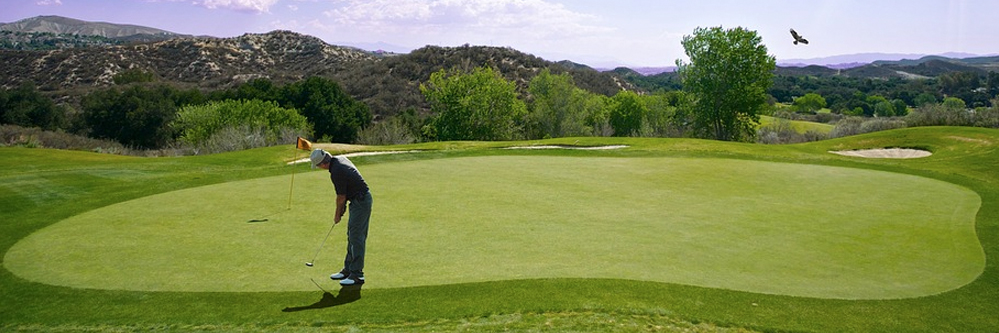
Starting any new hobby can be daunting; golf is one that can be quite overwhelming for beginners. You’ll find yourself with new jargon to pick up, clothing to wear and the potentially expensive elephant in the room; getting your hands on a set of golf clubs.
Whether you’re teaching yourself or getting lessons, one of the first places many people should start in golf is with putting. It’s the club you use the most, making it one of the most critical clubs to master. In this section of the article, we’ll guide you on what to look for and help you find the best beginner putter for your needs.
Recognizing The Difference Between Putter Styles
Blades
This style of club is perhaps the most recognizable style of putter for non-golfers. It’s got a simple flat looking head and is thin compared to other styles of putters. When TaylorMade introduced the now iconic spider style of putter, bladed putters made up roughly 80% of the market.
Peripheral Weighted
This design is also known as the “heel-toe weighted putter” is a development of the traditional bladed putter. These have a similar width and length in terms of clubhead but have added weight in the heel and toe. This development gives you added consistency through careful weight placement as well as more forgiveness.
Studies have shown that fitting weight, as well as the balance of your putter head, can be critical for supporting the strokes and putting performance.
Mallet Putters
Malleted putters have a much larger head design. With a larger club head comes more space for tweaking the club and adding technology. It’s not uncommon for manufacturers to assign alignment guides as well as shapes on the head to better guide players.
A perfect example of this is shown with the Odyssey White Hot Pro 2.0 2-Ball Putter. This has two balls modeled into the club head, so when you look down you can use them to visualize the alignment of your golf ball. Like other clubs with larger sized heads such as woods, malleted putters are more forgiving.
Putter Faces

So we’ve covered the three main types of putter style head wise, but if you’re buying a putter you’ve still got another decision to make. You need to understand the types of faces available, which play more of a role than many people think. After all, it’s the face of the club that makes contact with the ball; this has a significant impact on whether you end up putting the ball in the hole or not.
The putter face or insertion you choose depends somewhat on your preference. It can vary depending on the type of ball you’re using as well as the speed of the greens in your club. It’s worth checking out what your club pro recommends. If you love the sound a putter makes when it connects with the ball, you might be more inclined to go for a firmer perhaps metal face. Or you might feel quite the opposite and prefer less feedback when you connect with the ball. If you’re the latter, then a softer insert would probably be more suitable for you.
To help you better understand the types of putter faces and inserts available we’ve broken a few of these down for you:
Metal Faced Putters (pictured above)
These are often made of steel but not always with other metals such as titanium and aluminum also used. If you’re looking for a putter face with plenty of feedback, steel offers plenty. It’s a solid and robust metal with plenty of noise when you connect. If you like metal face putters, but not their sound, you also have options. You can get milling on the face of your putter, which produces noise by allowing less metal to come in contact with the ball.
Insert Faced Putters
The clue is in the name when it comes to these, practically speaking they’re a metal faced putter with a softer material inserted into the “sweet spot” of the face. It impacts more than just your connection with the ball; you’ll find more weight distributed at the heel and the toe of the club.
Softer insertions are considered more forgiving than metal faced putters although you do end up with less receptive sound when you make a connection with the ball.
Grooved Putter Faces
Groove putters don’t really fall into a metal, or inserted face category because they come in both types. The groove refers to the technology established on the face of the putter.
This type of putter face attempts to create a forward rolling motion upon striking of a golf ball. As strange as it sounds, shots struck along a green aren’t always rolling forwards, and certainly not smoothly. There’s a variety of other outcomes that might cause your ball to lack the accuracy you need. Sliding motion or backspin can create unpredictability and certainly reduce your precision.
Putter Shaft Length
Finding the right length of putter, just like finding the correct shaft size is vital for your overall performance with the club in your hand.
Height variations, as well as stroke styles, mean that there’s no silver bullet when it comes to putting shafts.
As we can’t identify the best-sized shaft for you, we’d recommend popping into your pro store the next time you’re at your golf club. Just be cautious about doing your research first before you purchase anything in store, make sure you check the prices out online as you might find something cheaper.
Putter Shaft Hosel
There’s more to a putter shaft than just its length. You need to consider the hosel, which is the point that connects your putter head to the shaft.
When it comes to making this decision, there are three main options that you should consider:
- Heel-Shafted Putters: These connect with the putter at the end of the head closest to you.
- Center-Shafted Putters: These connect with the club in the center of the head. Some golfers might find these more comfortable to use as the central placement can be used as an additional point of reference for lining shots.
- Hosel Offset: You’ll notice that these have an element of “bend” to them. As far as the actual connection goes, you’ll see that they connect in the same position as on heel shafted putters. The difference between the two is that your hands are in front of the ball upon impact due to the angle the hosel offset creates.
Putter Grips
We’ll finish off at the top of the club with the putters’ grip. What’s interesting is the impact that diameter has on the feel of your putter. A thicker grip will take your hands and wrists away from your stroke. This is key for enhancing your putting; however, you do get less feedback through your grip upon connection. Alternatively, you might rely on your wrist and hand action as part of your technique. In this case, you’ll be more suited to a regular style of putting grip.
Conclusion
Focusing on your putting might give you the edge you need to make rapid improvements to your game. Too many beginners focus on their long game and neglect that fact that the club they’ll be using most is a putter. We hope you’ve enjoyed the article and that you find the best beginner putter for your height and swing style.
